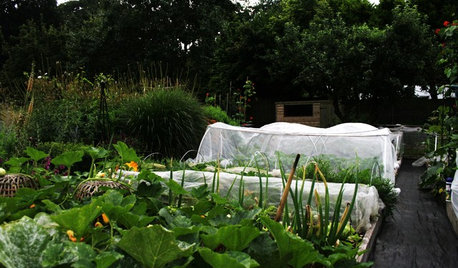Changing plant food question
Lamora
11 years ago
Related Stories


ORGANIZINGPre-Storage Checklist: 10 Questions to Ask Yourself Before You Store
Wait, stop. Do you really need to keep that item you’re about to put into storage?
Full Story
FARM YOUR YARD9 Ways to Change Up Your Vegetable Garden for the Coming Season
Try something new for edible plantings that are more productive than ever
Full Story
FEEL-GOOD HOMEThe Question That Can Make You Love Your Home More
Change your relationship with your house for the better by focusing on the answer to something designers often ask
Full Story
EDIBLE GARDENSFood and Community Thrive in a U.K. Allotment Garden
Get a peek at a rented garden plot in England where edibles and flowers mix and local residents can mingle
Full Story
FARM YOUR YARDHello, Honey: Beekeeping Anywhere for Fun, Food and Good Deeds
We need pollinators, and they increasingly need us too. Here, why and how to be a bee friend
Full Story
DIY Projects: Changing Your Look by Changing Your Table Arrangements
A guide to table decorations
Full Story
LIGHTING5 Questions to Ask for the Best Room Lighting
Get your overhead, task and accent lighting right for decorative beauty, less eyestrain and a focus exactly where you want
Full Story
REMODELING GUIDESSurvive Your Home Remodel: 11 Must-Ask Questions
Plan ahead to keep minor hassles from turning into major headaches during an extensive renovation
Full Story
Design Dilemmas: 5 Questions for Houzzers!
Post Ideas for Landscaping for a Modern Home, Updating a Rental and More
Full Story









pirate_girl
LamoraOriginal Author
Related Professionals
Beavercreek Landscape Architects & Landscape Designers · Garden City Landscape Architects & Landscape Designers · Seabrook Landscape Architects & Landscape Designers · Milford Landscape Contractors · Elmhurst Landscape Contractors · Kaysville Landscape Contractors · La Verne Landscape Contractors · Mastic Beach Landscape Contractors · Northbridge Landscape Contractors · Ocoee Landscape Contractors · Round Lake Landscape Contractors · Severna Park Landscape Contractors · The Villages Landscape Contractors · Wells Landscape Contractors · Mount Sinai Interior Designers & Decoratorspirate_girl
tapla (mid-Michigan, USDA z5b-6a)
LamoraOriginal Author
tapla (mid-Michigan, USDA z5b-6a)
LamoraOriginal Author
tapla (mid-Michigan, USDA z5b-6a)
LamoraOriginal Author
tapla (mid-Michigan, USDA z5b-6a)
LamoraOriginal Author
TheMasterGardener1